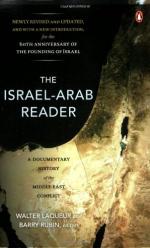
|
| Name: _________________________ | Period: ___________________ |
This test consists of 15 multiple choice questions and 5 short answer questions.
Multiple Choice Questions
1. What needs to be achieve for a solution to the problems in the Middle East to be final, according to Part IV pp. 384-430?
(a) The Palestinian people must have a defined, permanent status.
(b) Palestinians must be ready to make concessions.
(c) Israel must withdraw from occupied territories.
(d) The U.S. must stop supporting Israel.
2. What summit created a military relaxation between America and USSR?
(a) Nixon-Brezhnev.
(b) USSR Summit.
(c) Madrid Summit.
(d) Geneva Summit.
3. When was the Palestinian declaration of independence issue?
(a) November 15, 1988.
(b) November 15, 1987.
(c) November 15, 1989.
(d) November 15, 1986.
4. What did Walter Laqueur analyze?
(a) Prospects of war between Israel and Egypt.
(b) Prospects of peace between Israel and Egypt.
(c) Prospects of war between Israel and Jordan.
(d) Prospects of peace between Israel and Jordan.
5. When did Yasir Arafat talk about a letter from the United States which said that it would increase its presence in the Persian Gulf and would not tolerate any interference?
(a) December 13, 1990.
(b) December 13, 1992.
(c) December 13, 1993.
(d) December 13, 1991.
6. What does Shamir refuse to do?
(a) Recognized with the PLO.
(b) Negotiate with the PLO.
(c) Negotiate with Jordan.
(d) Negotiate with Egypt.
7. When was the Madrid Peace Conference, according to Part VI pp 577-623?
(a) October 31, 1990.
(b) October 31, 1991.
(c) October 31, 1992.
(d) October 31, 1993.
8. When did the Soviet start helping the Arabs?
(a) 1980s.
(b) 1970s.
(c) 1950s.
(d) 1960s.
9. When did Golda Meir tell the Knesset that Israel was open to accept a cease fire with the military where they were?
(a) October 23, 1975.
(b) October 23, 1976.
(c) October 23, 1974.
(d) October 23, 1973.
10. When did the PLO Executive Committee praise the action of those participating in the intifada?
(a) December, 1987.
(b) December, 1986.
(c) December, 1989.
(d) December, 1988.
11. Where did Israel gain land in during the Yom Kippur War?
(a) Lebanon.
(b) Egypt.
(c) Jordan.
(d) Syria.
12. What is the only solution to the Palestinian problem, according to Hamas?
(a) Negotiation.
(b) Jihad.
(c) Intifada.
(d) Terrorism.
13. How many points did the Baker plan have?
(a) 6.
(b) 2.
(c) 7.
(d) 5.
14. Who was the Israeli defense minister in December, 1981?
(a) Maurice Studd.
(b) Karl Kramer.
(c) Ariel Sharon.
(d) Joseph alenberg.
15. Why was overall peace but a dream during the Geneva conference?
(a) Israel didn't want to make any compromise.
(b) Most Palestinian organization call for the destruction of Israel.
(c) The PLO wanted to be the leader of the Arab organization.
(d) Most Palestianian organizations were not present.
Short Answer Questions
1. What did the Arabs have to accept before negotiation could take place?
2. Who was the Israeli foreign Minister in the spring of 1982?
3. When did Yasir Arafat address the U.N?
4. What could affect the balance of power according to Saddam Hussein in 1990?
5. Who proposed a peace plan in 1982?
|
This section contains 447 words (approx. 2 pages at 300 words per page) |

|




